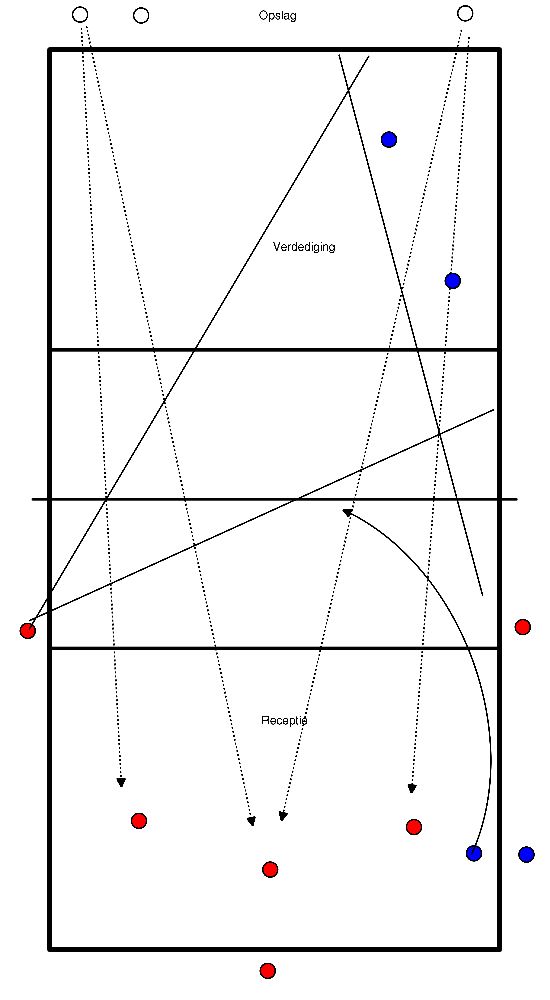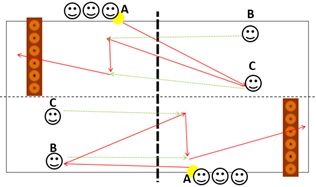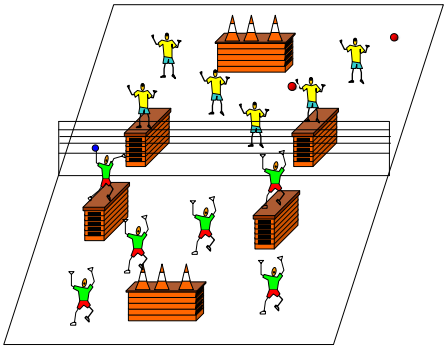Volleyball drills
- Two pairs are made.
- The players face each other. Player with ball has his back against the net, player without belly is in the middle of the square.
- Player with ball knocks on the ball, at this moment the player at the back stands up quickly because the ball is thrown into the field and must be caught overhand or underhand.
- The ball is thrown back to the player at the net in an arc underhand/overhand and starts over.
- We do this 5 times each.
- In the middle of the field a large square is made with 4 benches. Here 2 players stand.
- All balls are distributed in the hall and the other players are waiting for the trainer.
- When the trainer says start, the players must try to get as many balls as possible into the square.
- The 2 players who are in the square throw the balls back out again.
- After 1 minute the trainer checks how many balls are still in the square.
- ATTENTION:
- You may only throw 1 ball at a time in or out of the square!
- Storage -> reception -> pass to 4 (diagonal) alternating with 2 (street) -> defence with 2
- Variant: attack on 4 (street) alternating with 2 (diagonal) 7
- Receptionists always turn around
- After 2 good actions turn around


- Player A throws ball over the net.
- Player B or C passes the ball over the net.
- The other player quickly runs under the net and sets up the ball for the same player who passed.
- This player tries to get a pawn off the bench with overhand play or a hitting move.
Which pair or team has knocked the most pawns off the bench after X number of minutes?
- Grouping into 2 groups,
- Each group gets a small mat and the opponents must try to hit the mat with a ball.
- If they hit the mat they get a point.
- If the mat falls, the opponent gets a point.
- free ball is brought in by reception player
- then the pass is given
- and the attacker attacks in a defined zone.
- Point system:
- out: -1,
- net: -1,
- in: 0,
- inside the box: +2
- Free ball -> pass -> diagonal attack:
- 3 blockers,
- 2 defenders who choose between 5/6 or 1/6
- and 2 attackers on 4 and 2 who attack diagonally.
- In pairs with 1 ball and with the net in between.
- On a 3 meter line and serve calmly to each other.
- Throwing up and concentration.
- Same but increase the distance.
- If it goes well then increase the distance again.
- The ball has to be caught by the other player.
- If the ball falls you go one meter forward.
1) running (on stockings
) 2) stretching
1) Shoulder pumps2
) T-Y-90/90 exo (arms lifted outstretched)
3) planks 1'
4) superman 16x5
) deadbug6
) planks 1'
- The 2 throwers stand on the boxes and the attackers walk on the ground.
- The throwers and attackers try to knock over the pylons or throw off attackers at the opposing team.
Rules:
- You are not allowed to defend your pylons, you can use chalk to make a circle in which the pupils are not allowed to stand.
- As a thrower and as a declarer you can choose to aim at the declarer or at the pylons.
- The defender is not allowed to fend off but if he catches the ball the thrower is out and a new thrower has to come in
- When a player is thrown out, he/she has to sit on the waiting bench, when a pylon of the opposing team is knocked down, all the keepers can go in again.
- Throwers cannot be thrown off.
- When the opponent's pylons have been knocked down, you have won the game, or when all of the opponents' helpers have been removed.

Play fanatically in threes. After you play the ball, walk to the other side and connect. Player A plays to player B and connects with player B at the back. Player B plays to player C and connects with player C at the back. Etc.
Next:
- 1 with ball at the net,
- 1 without ball on the backline, flat on belly.
- Attacker hits ball, defender defends on 7meter line,
- Then short ball on 3meter line.








